I love (good) books. As a child, I was a huge bookworm. As a mother, I could seriously read to my children nearly all day long if they would let me! I think one of the most personally devastating parts of discovering our daughter’s Cortical Visual Impairment (CVI) diagnosis for me was the realization that reading books with her (and teaching her to read) will likely require a great deal of adaptation – and it simply will not be the same experience as I’ve had with her big brothers. Still, I am filled with hope because some children with CVI can become skilled readers – and even fall in love with literature.
In her (new!) book, Cortical Visual Impairment: Advanced Principles, Dr. Christine Roman-Lantzy writes:
“I now know that some children with CVI will achieve the prerequisites for reading and ultimately become competent readers, while others will follow a different path. But I cannot foresee ahead of time which individuals with CVI will read, so I believe that all children must be provided a path to literacy. Some will use symbol systems that are not word based. Others will learn a discrete set of words that can be used for short passages or functional reading. Still others will become skilled readers who will ultimately read fluently, with comprehension and pleasure…. So I encourage my colleagues to take the risk of believing that your students with CVI are capable of literacy no matter what form it ultimately takes….” (p. 37)
Personally, at this point in time I must choose to believe that Rosalie (my daughter with CVI) can and WILL achieve literacy. Right now she is only 16 months old, so we have a long way to go on a path to literacy – but she takes an interest in 2D images (a skill that typically emerges in Phase II CVI) and is at a great age in regards to neuroplasticity. This is a prime time to read picture books with her and focus on building her repertoire of “known” objects!
But, I’m also a mother to three young children that is now extra busy navigating the complex world of special needs parenting, so finding time to make and/or adapt books for Rosalie feels next to impossible (we’ll get there someday!). How do I introduce picture books without making my own or constantly adapting them (yet)?? Well, I have found books that are already visually accessible to my daughter – without me needing to make adaptations!

This list features books that offer highly-saturated colors, simple (low complexity) objects and background pages, and even some movement or shiny/reflective properties that can be visually perceived as movement. These features address the needs of at least 3 of the 10 characteristics of CVI (color, complexity, movement).
A note on “black and white”: When I first began researching CVI I kept seeing people online say things like, “never use black and white patterns for a child with CVI! It’s too complex.” But you know what? Rosalie’s very first preferred colors were both red and simple black and white (which was clear to me even before we knew about her CVI). I think it’s important to remember that when we make sweeping statements about what children with CVI can or cannot see (without considering the actual skills of a specific individual) we can potentially be limiting our children. Will black and white images work for your child? Maybe not! The key is to follow your child’s lead to find out what piques their visual curiosity and attention. I hope this book list can generate some helpful ideas for you.
1. Hello, Animals!
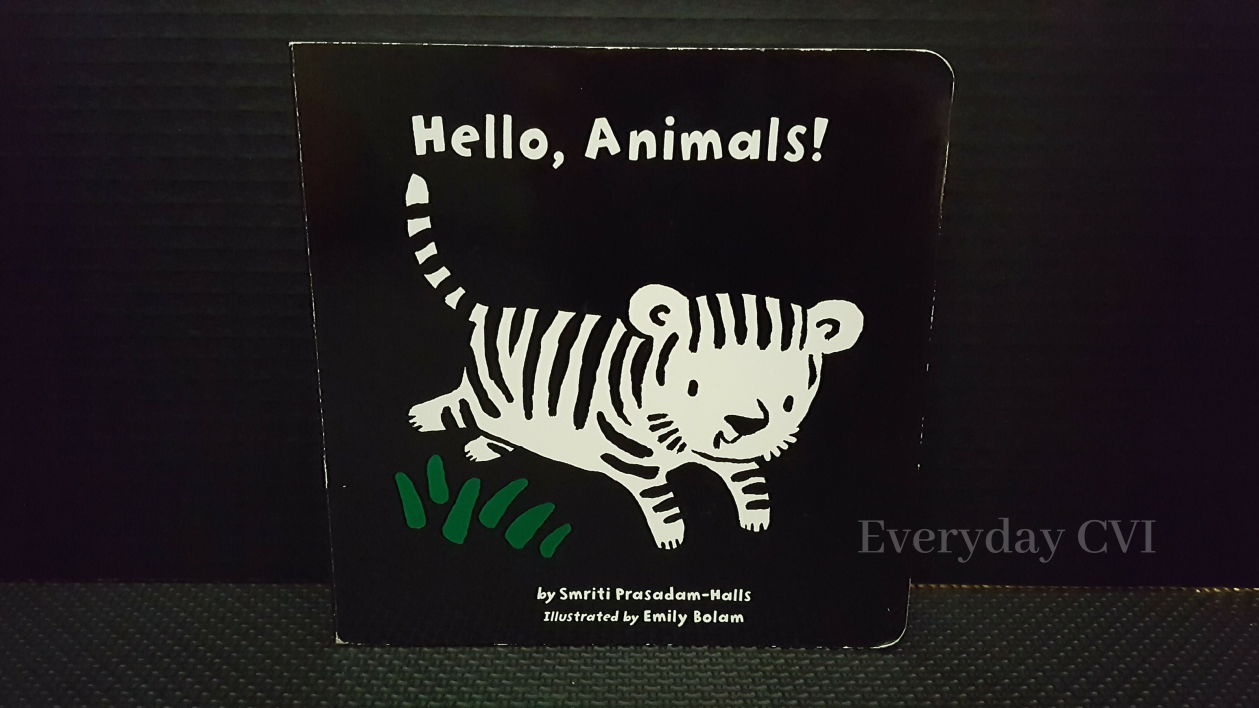

Hello, Animals! by Smriti Prasadam-Halls is a board book that features mostly black and white pages with pops of shiny color.
2. Hello, Bugs!
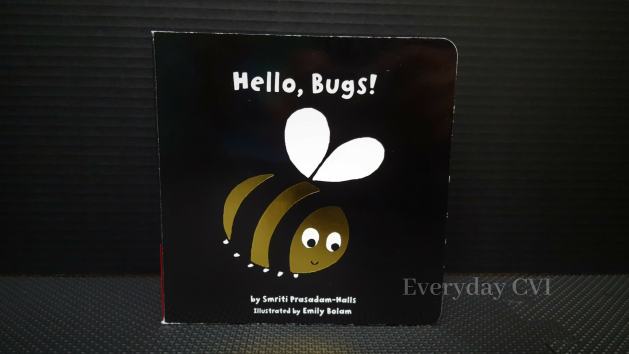
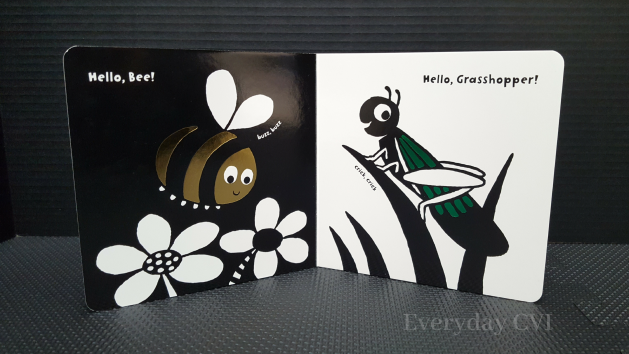
Hello, Bugs! by Smriti Prasadam-Halls is just like Hello, Animals! – but with bugs. 🙂
3. Spots and Dots (Art-Baby)

Spots and Dots (Art-Baby) by Chez Picthall is a book of…you guessed it: spots and dots! It’s a series of high-contrast patterns.


To be honest, I would have thought this book was too visually complex for Rosalie back when she first saw it at 12 months old. To my surprise, she perked up as soon as it was shown to her and looked at each page intently. This served as a helpful reminder that I should not automatically dismiss things based on the complexity I perceive; Rosalie will let me know if she likes looking at something or not!
If you like this one (or the first two on the list), check out these other books:
- Baby Animals Black and White by Phyllis Limbacher Tilder
- Look, Look! by Peter Linenthal
- Look at the Animals! by Peter Linenthal
4. Emma Bear’s Day
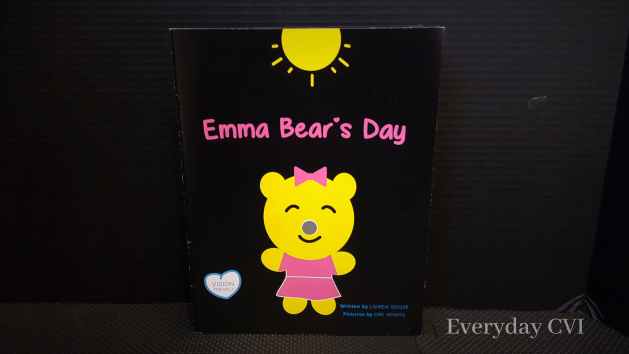
Emma Bear’s Day by Lauren Seeger is a short and sweet story of the main character, Emma Bear, going about her daily activities. Because Lauren’s daughter has CVI, she knows the struggle of finding suitable books – which is why she made her own!

The high-contrast book features simple, bright images on black pages. Emma Bear’s nose is also made of a reflective circle. Rosalie seems to enjoy this book a lot! Get your copy (and support the efforts of a fellow CVI mom) here.
If you like this one, check out the special Christmas edition also by Lauren Seeger:
5. ABC Look at Me

ABC Look at Me by Roberta Grobel Intrater was a freebie we received from Dolly Parton’s Imagination Library. Imagination Library is a nonprofit that sends books to children from birth to age 5; if the program is available in your area, all you have to do is register your child(ren) and they receive one age-appropriate book each month! I signed all of my kids up for the program as soon as it became available in our county. Of course, most of the books are not visually accessible to Rosalie without some major adaptations, so I was thrilled when we received this one! She does well looking at faces, so she enjoys this book.

Each page is high-contrast with black pages and bright letters. Every letter of the alphabet features a photo of a real baby; faces are known to be visually complex, but children with CVI typically process REAL images better than cartoon drawings. Covering up the other letters and pictures on each page (I use a black fabric square/cloth), we can focus on one image and facial expression at a time. Discussing salient features of varying facial expressions can potentially help children with CVI better recognize/understand social situations (of course this will depend on your child’s level of ability when it comes to the complexity of faces).
If you like this one, check out these other books by Roberta Grobel Intrater from her “Babyfaces” series:
6. The Happy Little Yellow Box

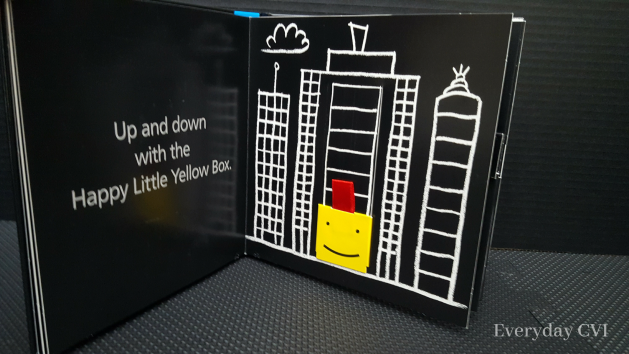
The Happy Little Yellow Box by David A. Carter is a low-complexity, high-contrast book of opposites, which caters nicely to the CVI characteristic of “movement” with its several pop-up pages. Rosalie particularly enjoys the page where the yellow box is flying like a helicopter!

If you’re looking for some creative ways to enhance your child’s experience with books, Diane Sheline used this one as an example of Modification of Existing Books on her website Strategy to See.
If you like this one, check out this other book also by David A. Carter:
- B is for Box: The Happy Little Yellow Box (an alphabet pop-up book)
7. Opposites
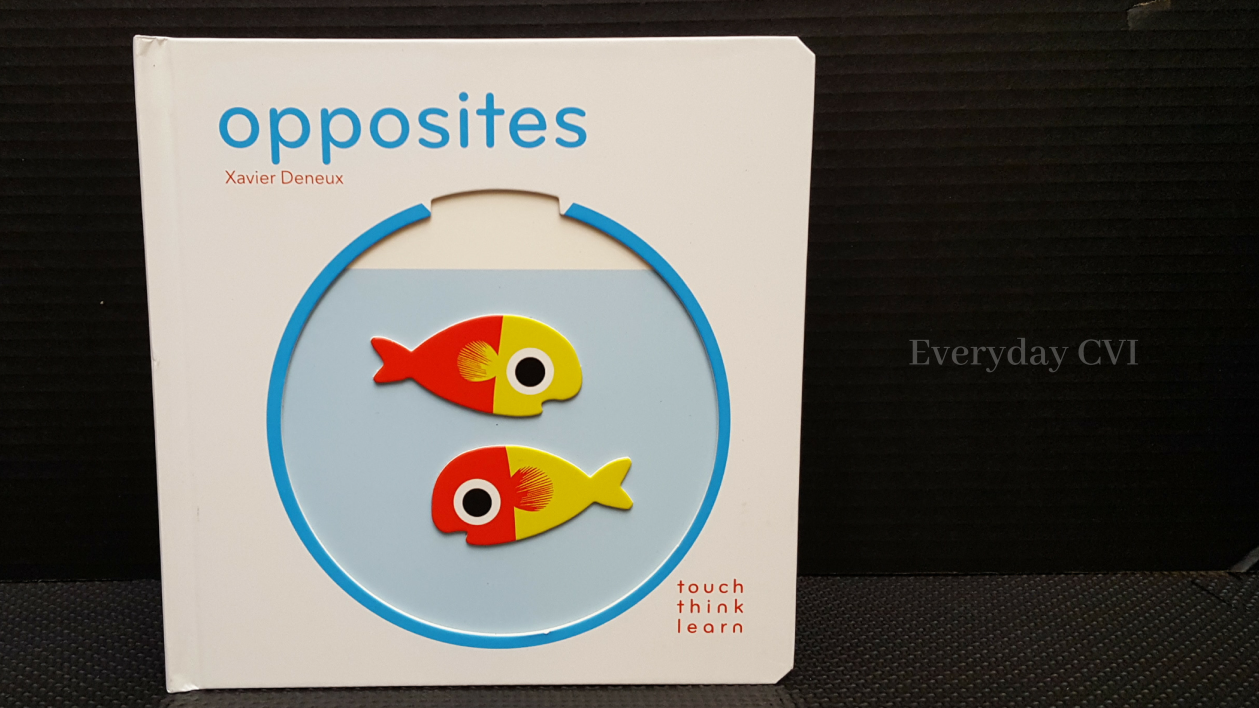
Opposites by Xavier Deneux is a hands-on, multisensory book of opposites. The pages are white (except for the black “night” page) with brightly-colored, simple images that are raised and/or scooped out surfaces.

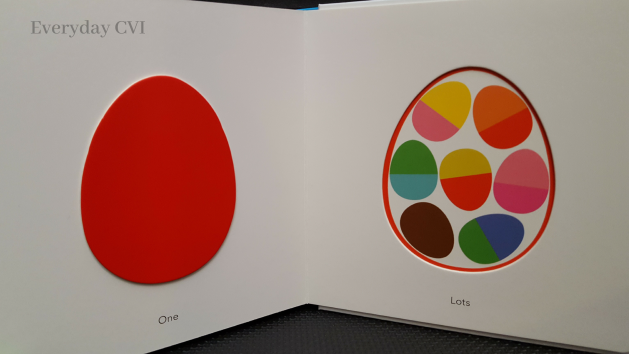
If you like this one, check out these other books by Xavier Deneux:
8. So Big!
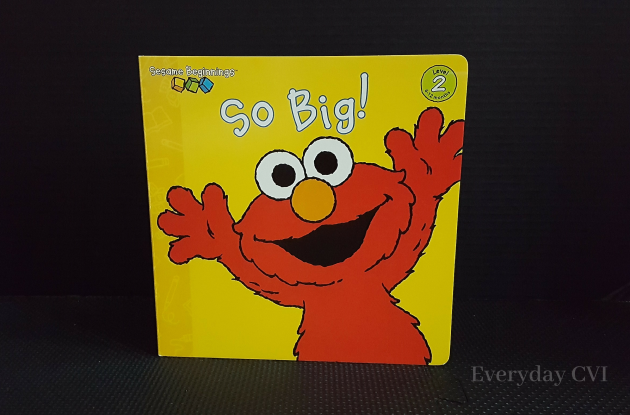
I mentioned So Big! on my list of “14 More Gifts for a Child with CVI” after Rosalie received this as a Christmas gift, but since then it has become a daily staple of Rosalie’s playtime. Each page features a solid-colored background, a simple image of Elmo, and a short line or two about what he is doing.

This list is full of books that I have not needed to adapt for Rosalie, but if the colored pages are too much for your loved one(s) with CVI check out how Lauren Seeger, the author of Emma Bear’s Day (listed above), easily simplified this book with some black acrylic paint.
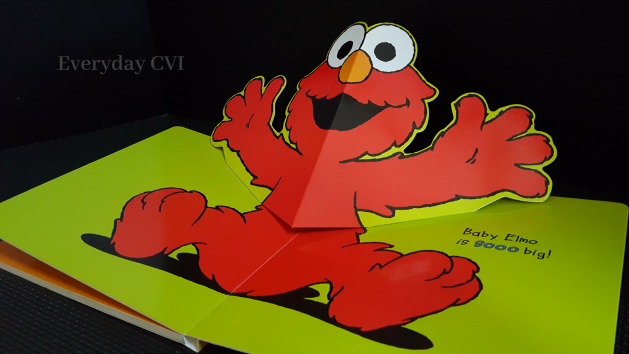
The final page features a large pop-up Elmo along with the words “Baby Elmo is SOOO big!” Rosalie adores this book right now (especially the page where Elmo says “la-la-la” and laughs “ha-ha-ha”), so it was an absolute “must” on my list of beginning books for CVI.
If you like this one, check out these other books:
- Monster Faces (Sesame Street)
- Pat-a-Cake and Other First Baby Games (Sesame Beginnings)
- Blue Goose by Nancy Tafuri
What would you add to the list? Feel free to comment or email me with your favorites! And make sure to check out American Printing House for the Blind’s extensive list of Resources for making/modifying books.
This post contains affiliate links. As an Amazon Associate, I earn from qualifying purchases at no cost to you.
“What I tell educational teams or therapists working with my child is – it is always a good idea to describe the salient features or details of people and social interactions. But we cannot have the expectation that a child with CVI will eventually learn to interpret faces and facial expressions – because latency, complexity, sensory complexity, distance etc. Interacting with a real person in a real situation is completely different from looking at a still image of a face or a person. We cannot have the expectation that our kids will learn this kind of visual interpretation. And this kind of thing is different from say, me wearing color specific clothing so that my son can better recognize me in a crowded situation.”
LikeLike
Yes, that is an excellent point. 2D images are very different from real-life interactions. Thank you!
LikeLike